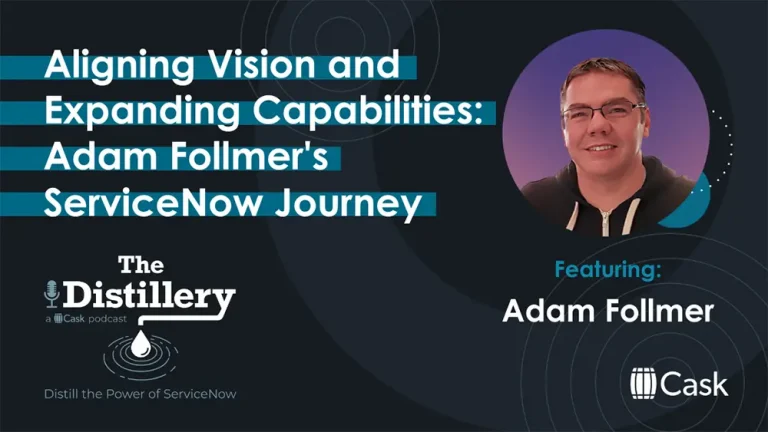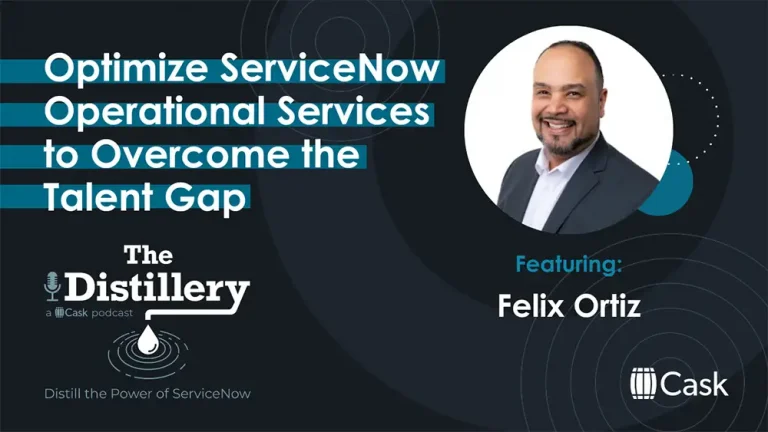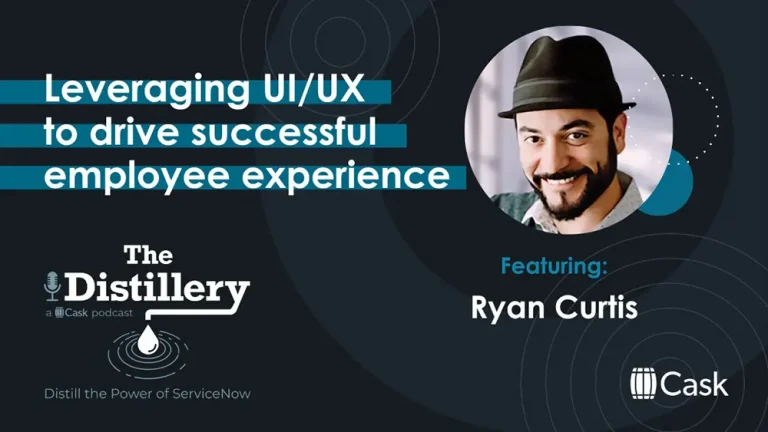Your Host:
Sean Dawson
Our Guest:
Matt Soccio
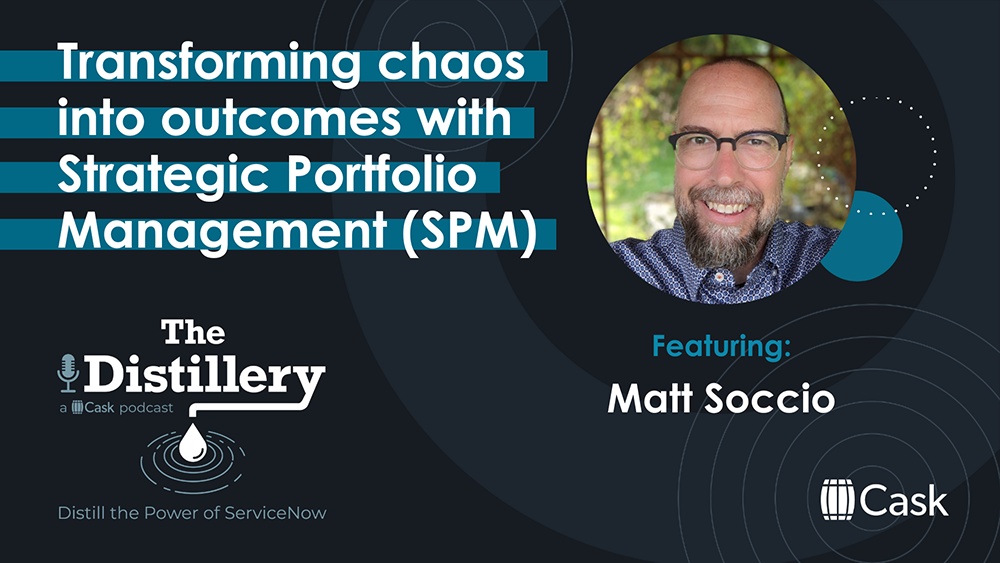

Explore how to avoid project overload and chaos to drive outcomes that matter with ServiceNow's strategic portfolio management. Sean Dawson taps the expertise of SPM specialist Matt Soccio to demystify core concepts like "ungoverned demand" and showcase SPM's enterprise-wide potential beyond IT. Gain insights on increasing capability maturity, enlisting executive sponsors, and selecting the right pace for your organization. Learn how SPM accelerates benefit realization, optimizes resources, and bridges silos through shared data-driven decisions. Take your SPM practice from reactive to proactive governance with this practical discussion.
Sean Dawson: Hello and welcome to the Cask Distillery Podcast, where we unlock the full potential of ServiceNow with another set of expert insights and practical strategies only here on the Cask Distillery Podcast. I’m your host as usual, Sean Dawson.
And with me, I have Matt Soccio. And Matt has 20 years of IT experience on enterprise transformations and also 10 years of implementing and maintaining ServiceNow instances. He works in the higher ed, federal, civil, state, local governments, commercial—you name it, Matt works in it. And he is our associate director of strategic portfolio management here at Cask. Welcome, Matt.
Matt Soccio: Hey, thank you, Sean. Great to be here.
Sean Dawson: And thanks for taking time. I know we’re all busy here, and I just want to thank you for the time and coming on here to add some value to our listeners and watchers—however they’re consuming these podcasts—and talking about approaching SPM with your org and, really, how to avoid the overwhelm and start realizing the value of SPM.
Matt Soccio: Thank you for having me. I think you’re going to find I’m pretty passionate about this, and I enjoy talking about it.
Sean Dawson: For the listeners, Matt and I, as far as the practices and I go, as you know, I’m a client architect here at Cask, and I work with Matt a lot on different accounts. So we know each other. So this will be a fun conversation.
On the podcast, we try to start out real high level, so I was wondering if you can give me a real high-level overview of strategic portfolio management, also known as SPM. We used to be ITBM, and they’ve added things to it. But I wanted to see if you could give an overview as a whole as it’s gotten kind of large.
Matt Soccio: Oh, yeah, and that’s a great place to start because you mentioned all those market spaces. Something they all have in common is there’s only so much money and staff time to get all the stuff done that we need to do. And some of that is keeping our lights on, and some of that is growth and innovation work.
And it’s really hard to balance that. And so what SPM at the core of it is really about aligning those limited budgets of hours and dollars to what we want to become at the end of the year, at the end of the quarter. So what we’re doing is starting with our strategic plans and then getting a series of repeatable, interlocking processes that allow us to consider what work do we really want to do. Do we have the time and the money for it? And then if we do decide to do stuff, is it actually producing the value that gets us those strategies and goals? And so really what it is is it’s a way to get us some really lean governance and make sure that we’re actually achieving our goals and our strategies
Sean Dawson: Coming back to the value, I know that project management in general, there’s a huge failure. It’s a pervasive problem, and there’s a lot of other interesting stats from PMI and other industry consultants about project failure. But why do you see that project failure is such a pervasive problem in the industry right now?
Matt Soccio: A lot of it has to do with that strategic alignment. Some of the stats we got—Inc Magazine did a study and worked with executives, and when they started having them look backwards, they said upwards of 65–67 percent of strategic plans they felt were failures. And when they look forward, and they say there’s about three quarters of the executives didn’t feel like they were going to be able to achieve their strategic goals. So there’s this big alignment piece there.
But what we’ve really found at the practical level is this term we call “ungoverned demand.” And this is the funnel problem. Everybody’s changing their mind, the priorities shift, and it’s always the scramble to rearrange where the money is, where those hours are going, and what we’re really going to try to get out of it. And that constant churn is generally what starts to impact how much value we get out of that project work.
Because if you stop and think about it, I’ve got a team of eight people that are keeping the lights on for my whatever big platform: Salesforce, Oracle, SAP, whatever it is—it can be any of our IT assets. I’ve got a team of eight people. Now we need to do a major upgrade and pull people off for a project. What happens? What happens in that KTLO space? How do we manage that? And then, somebody goes on maternity leave, or we have timing issues, and suddenly that project starts to draw out, and other demands are continuing to come in. We have yet to meet anybody whose pipeline is stagnant. It’s always growing.
And so how do we deal with that pipeline growth? How do we balance that with the realities of the staff that we have, the hours available, the skills available, and still make the time intentionally for those innovative and growth pieces? And when that demand and that balance isn’t—when you don’t have good data, and you aren’t intentionally balancing those things, we find that projects are—there’s just resource collisions all over the place. There are schedule slippages. There’s missed expectations.
Those are the ones that are really tough to deal with. I’ve been on several projects where we get to the end. It’s, “Hey we were green across the board. The project went great.” And the executive sponsor says, “I’m looking at my balance sheet. Where’s my 20%?” And so it’s those kinds of things. You can’t wait till the end of the project to discover that your expectations are misaligned.
And what we find it’s really not about: No project tool is going to fix those things that we talked about. None of them are going to fix it. It’s really about getting these processes. And the words we use in the SPM in our team, we call it a “discipline” or a “practice.” And so it requires that kind of rigor and discipline to make sure that we’re keeping our pipeline in order. That we are respecting our resourcing constraints and really delivering the right things and getting beyond that red, green, and yellow.
Sean Dawson: Yeah, and you mentioned in a couple of spots there things that are financially driven. The one thing I wrote down was “balance sheet,” and I wanted to get your thoughts on how big is the economy of projects? In other words, everyone has project work. So how does that impact the wider economy?
Matt Soccio: Oh, it’s big. When we were doing some research on this about project failures and looking across the markets, there were some some neat information in a Science Direct article that we found that basically says a third of the world’s economy is project work. Think about that. A third. And obviously that’s going to vary company by company.
But when you stop and think about that, if we at Cask, a third of our work is development at the government, a third of the work. And to not have good rigor and discipline and a good practice around something that big, it leads to some pretty tough places when that isn’t managed well. And PMI, obviously, they do surveys every year and have statistics around it. And what they find is that as people really pick up strategic portfolio management that we find that there’s, again, almost a third less budget leakage due to staffing collisions or schedule slippages or overruns. We also find that there’s almost a third less project failure. The stuff that we were just talking about.
But the one that I really like to focus on is that, by adopting SPM, you can get over a third more of your goal achievement. And if you stop and think about the balance sheet example, imagine being able to go to your executive sponsors and say, “Not only were we green across the board and we ran the project well, and the staff were happy, but you, Executive, now can check off these three boxes on your strategic plan.” And that’s huge.
Sean Dawson: Yeah, absolutely. And this is a loaded question, because I know this, but I wanted to ask: A lot of people think of SPM as strictly about project management. Is it just about project management?
Matt Soccio: No, it is not. Projects are at the core of it. And it’s what we think about because we stand up organizations around that there’s PMOs. PMI has really good processes that help guide us with project management, but there’s a lot of things that happen around project management that we also have to have that same PMI-level discipline around.
And so how we do our strategic planning, it matters. If you don’t set your goals correctly and realistically, it’s going to be—no project can help you meet bad goals. So strategic planning matters. How you manage your pipeline—we call that “demand” in ServiceNow. But really, most people would recognize it as “We have a backlog or a pipeline of work that is backed up.” And the ability to compare those things as apples to apples and to be able to prioritize and rank that work and understand when to take that work on when the staff is available, when the funding is available, that’s a big deal. There’s a lot that goes on before we even get to project to make sure that we have the resources, to make sure that the business case is solid, to make sure that we are managing things like risks and benefits.
And that’s one of the big things with our clients that we introduce new capabilities is around benefit planning. And when we talk about that, what that really is there’s a lot of people say, “Oh, what’s the ROI? What’s the return on investment? I really want to know that.” We can’t do an ROI calculation without understanding what the benefits are out the back end, because you spend all this money during the project, but to what end? And so, if you don’t do that estimate up front, we can’t do the ROI calculation. And so there are some advanced financial concepts on the front end there that we like to help people adapt and adopt so that they can see more of what’s going on once the project does execute.
And, of course, again, if you are doing project management and just doing the normal red, green, yellow status reporting there, it’s really hard to get that lean governance going where you’re making the hard trade-off decisions to say, “Hey, the schedule is going to slip by six months. What do we do with that project? What do we do with the resources assigned to that?” And it can really help to change governance.
And one of the concepts we talk about a lot when we’re engaging our customers is this bridge between the business and IT. And by changing this conversation and having more of this language of the business, the benefit realization, the risk management, the goal achievement, that bridge starts to build, and you change the conversations, and you bring the business in and say, “Here’s what we know. How do you want to order this?” And that forms a true strategic partnership. And that really elevates IT. A lot of times, we expect that partnership to form, but you really got to get this governance down to start to build that bridge.
Sean Dawson: So hopefully that raises some flags for some of the platform owners that are always wanting to expand footprint and how to help. But this is it right here is bridging that gap as you said. So go ahead—did you have more?
Matt Soccio: And I’ll be honest with you. Again, the stuff we’re talking about isn’t just IT. You can do—strategic portfolio management can cover HR. It can cover finance. It can cover other things. But a lot of where we are with our ServiceNow customers, we come in through the IT door, and they want to build the strategic partnership.
Sean Dawson: We’ve defined now what SPM is. It’s a big arena. It’s a big product. So how do we help customers step in and approach SPM?
Matt Soccio: So what we really recognize—and again, we really haven’t talked ServiceNow; we’ve mentioned it a couple times—but when we approach this, we really like to look at the ServiceNow platform and say, The platform has these features that we can leverage, and people have capabilities.” And sometimes we’ll get in with some of our clients and their capabilities will be really high, but they’re in spreadsheet nightmare scape. And so we get them those features and it really helps their capabilities accelerate. In other places, we find that they’ve tried several tools with all the features you can imagine. But the capabilities haven’t been elevated, so we try to really spend the time up front with our clients to understand what does it look like for your organization to really adopt these features and these capabilities together and mature them at a rate that the organization can actually accomplish.
Because a lot of times, we’re in the space of PMOs, of C-level folks. These folks don’t have a lot of time to spend to develop new capabilities or to learn new features. And so really understanding “How quickly can you change?” “What are the key gaps in the features and the capabilities?” And that allows us to really weave together and build an approach and a roadmap for our clients that says, “Let’s start with what you can actually bite off and chew and build from there.”
Sean Dawson: Yeah, that’s awesome. Thanks for that. And what I heard in that, and it was one of the things I was going to ask you about, but it’s more of a statement now is we need to be thinking about the capability, not necessarily the tech. We want to be thinking about the end game.
Matt Soccio: And that’s one of the things that’s great about ServiceNow and the way that they’re investing in the SPM tools and modules is that the tool really has a high level of maturity now, and it’s really about getting people in the space to collect the right data so that these features light up and they can really start to get to that lean governance and make some of those hard trade-off decisions. The platform ServiceNow has done a great job of getting us where we can really spend more time focusing on the capabilities and not having to fight with the features to fill gaps because people have certain processes or need to run certain reports. ServiceNow has really done a great job of getting the feature part matured.
Sean Dawson: So, again, going back to the platform players and the people that are out there dealing with the platform—they want to expand and be that digital transformation—who are the players and personas that would even care about SPM to guide them? Who would you talk to in the organization? And maybe they know it. I wanted to give the opportunity to hear from you, who deals with this every day. Who were those other players that they would need to approach?
Matt Soccio: I’ve mentioned a few of these roles. But if I want to start at the platform level and say, “Hey, we’ve got this great tool that can really help us get our data to the point that it’s a strategic asset and has that vision,” they can start within IT and work towards their PMO. Obviously, project management is a big part of this. It isn’t just project management, but working with your PMO directors and SVPs that are doing capital planning and investment controls are people that the platform owners could look to start the conversations with. We really find that the conversations change when we start talking with financial officers, whether that’s your business-unit-level financial officer or at the C level. I’m starting to see the money spent, the staff invested, and the results out the back end are things that we find that the financial officers really start to care about. So make friends with them. Take them out to lunch.
And some of the other roles that we talk about—I mentioned that bridge before: You have IT over here with all the technology, and they handle issues, and you have the business over here with their problems. And I’ve talked about the financial officers in the C suite over here on the business side. But to help build that bridge, you also have folks that are in that strategic space. So whether you have BRMs in your organization, or if you have strategic planners—sometimes business analysts will help bridge that—but you definitely need to start thinking about who can talk both of those languages and start pulling them in. So it is really a wide and diverse range of roles that goes the whole way from the C suite down into the PMO and—well, not down into, but into the PMO—and out to our platform owners. And so we all play our role here. But there is a wide diversity of roles.
And when we talk about this, we find that SPM gets that traction to really build the discipline and practice when you do get those CIOs, CFOs, COOs involved, because when they see what they can get and the decisions they can start to make, that’s when you get the funding to invest in this. That’s when you get the funding for the extra staff to help the PMO run this. The PMO is always going to be saying, “We need more staff.” But now, if the COO says, “The PMO needs more staff,” your chances are a little better.
Sean Dawson: One last question about product is really around because SPM is a deep product. And I know that it touches a lot of things, but I wanted you to highlight that for those that aren’t super familiar with it. What are the other areas that SPM touches?
Matt Soccio: We’ve talked about demand project, some of the really nice reporting things. SPM can also help your enterprise architecture group. And as you’re doing your ITAM and ITOM work and getting really good CMDB data and getting your services mapped, that can feed up to the strategic level and start helping your enterprise architects do their technology portfolio management, their application portfolio management. And again, thinking about those conversations with your financial officers, they all want to know TCO (total cost of ownership) all day, every day.
And, really that’s one of the big connections between the IT work and all that stuff we do to collect our asset data and understand our services and assets. It starts to connect to SPM, because we do want to know what that costs, and we do want to know how much it’s going to cost to improve it or change it or retire it and start to make those strategic decisions with more information—with a better business case—as opposed to just saying, “This is the new whiz bang thing. We’re just going to put that in.” You start to become more strategic about how you manage your technology portfolio, your application portfolio, your information portfolio.
We also connect out in the DevSecOps space. So the agile module is incredibly powerful for managing scrum-type work to handle epics and stories and to be able to power some of that development work. And the great thing is is that, if you’re using a lot of epics, those can come into our SPM consideration space, and we can have our business cases with those and our performance of those, just like we do with our projects.
Sean Dawson: For the last thing, I’ll also ask you this as well: Is there anything else that we missed? But I wanted to come back and highlight one thing: Is there anything else you’d share for those platform owners who truly want to serve in that digital transformation partner role for the organization?
We’ve talked about little opportunities with SPM, but what would you like to highlight out of that? Get them to the next step.
Matt Soccio: I’d really like platform owners to understand that the ServiceNow platform is your ERP for management information. If people say they want data-driven decision-making, ServiceNow across the whole platform can get your workflows, your HR, your IT, some of your biggest staffing and process expenses. You can now start to get that data in one place, and it can really answer the question, “Do we view our data as a strategic asset?” And ServiceNow is there ringing the bell, “We can help you with that!” And if they start to shift the focus away from a ticketing system or a ticketing mentality to the strategic asset that we have in data. And this is really where we go for our data-driven decision-making with performance analytics across all of the planks of the platform, with these new workspaces that ServiceNow is investing in. It is really the place to go to ask the questions about “How are we operating? What are we going to look like in the future?” And if platform owners can start to get those talking points and make that business case, they’re going to find they’re in different meetings than with the service desk director or the engineering director and things like that.
Sean Dawson: That’s our time for today, Matt. Thank you again so much for the time that you spent with us and our listeners. Really appreciate it. It was a great conversation.
Matt Soccio: I loved it, Sean. I’ll gladly talk to you anytime, man. Thank you so much for having me.
Sean Dawson: It’s good to know. And, again, for the listeners, again, thank you for watching, listening, however you’re watching this or consuming the information that we provide on the Distillery Podcast. Also, if you would be so good as to rate us, give us a like, subscribe, whatever it is. Let us know how we’re doing as well. And again, have a great day. Take care. Bye.
We’re with you for what comes next
You're working in a rapidly shifting environment.
Global dynamics, AI advancements, heavy competition–the only certainty is change.
We get it. And we’re here to help you harness the full potential of ServiceNow to simplify transformation.
Let's navigate the future together.



Recent Episodes
We’re with you for what comes next
You're working in a rapidly shifting environment.
Global dynamics, AI advancements, heavy competition–the only certainty is change.
We get it. And we’re here to help you harness the full potential of ServiceNow to simplify transformation.
Let's navigate the future together.



Let’s Innovate Together!
Request a Complimentary Consultation from Cask.
Cask’s unparalleled expertise is ready to tackle your unique challenges and transform your aspirations into reality. We’ll listen to understand your requirements and offer a tailor-made approach that aligns with your strategic objectives.
Your journey to innovation is just a click away. Schedule your meeting with our Cask advisors and become part of the success story that defines your organization’s future.
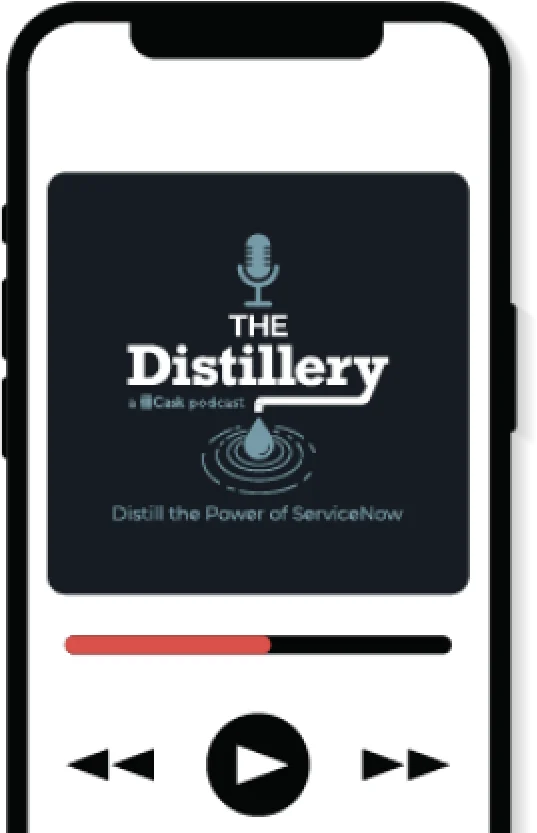


Sign up for our Distillery Podcast
Stay up to date with the latest episodes












